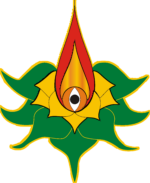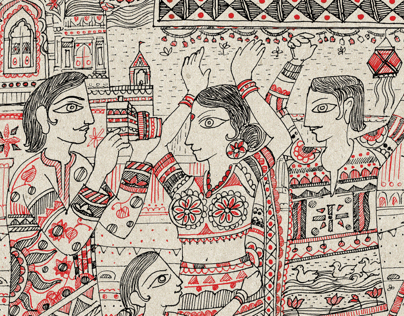This was first published in the print edition of Manushi journal, Issue no. 148 of 2005.
Seemanthini Niranjana, who has examined the relationship between gender and space, has written about women’s spaces: “In any attempt to relate space with gender, what would be immediately apparent is the centrality of women to the formation and continuation of the domestic space”1 Even today, when societies are becoming broadminded and ‘modern’, a public space is still not usually considered a woman’s place. This article looks at the movement of women outside the domestic sphere but in a special kind of public space that is demarcated as appropriate for women. Neutral spaces do exist, but are limited to only a certain portion of the day. Any public place can be generally accessed by men but women are subject to a lot of conditions such as their purpose for being there, the time of day, what kind of place, and whether alone. Such conditions can render women dependent, immobile and lacking in confidence. There is, however, a public place for women in the city of Mirzapur, 70 kilometers west of Varanasi where such conditions don’t apply. It is a women’s bathing ghat and a women’s bazaar along the river Ganga. It is known as the Pakka Ghat.
 Many other ‘zenana’ ghats exist, but one seldom finds the situation of public space such as the Pakka Ghat exclusively for women because it encompasses a market place, religious centres and a place of congregation used only by women. For ease of reference, henceforth in this article, the term Pakka Ghat is used to refer to not just the place of bathing but the whole area of market, temples, ‘chowk’ and other such spaces lying within its domain. The liberty extended to women and their ability to roam around this area is unusual. The fact that it is not just a market but a private bathing ghat also makes it a very special place.
Many other ‘zenana’ ghats exist, but one seldom finds the situation of public space such as the Pakka Ghat exclusively for women because it encompasses a market place, religious centres and a place of congregation used only by women. For ease of reference, henceforth in this article, the term Pakka Ghat is used to refer to not just the place of bathing but the whole area of market, temples, ‘chowk’ and other such spaces lying within its domain. The liberty extended to women and their ability to roam around this area is unusual. The fact that it is not just a market but a private bathing ghat also makes it a very special place.
There is a sequence of functions on the path leading to the Pakka Ghat starting from the main road to the river edge. It is like a procession with various sensorial effects of lights, sounds, smells, colours and textures varying twice a day. A large number of women visit the site early in the mornings for their bath and in the late noon or evenings for shopping, since most shops open only after 10.30 in the morning. The Pakka Ghat bazaar also has many temples and shrines that include the Shiva Temple, which is a little older than the Pakka Ghat. There is a courtyard (known as a chowk locally), just after the market ends and before the river is accessed. The chowk is used for congregations and for putting up stalls during festivals and special occasions.
Beyond the pavilion, there is a long flight of steps with landings that takes one down to the river. There are some priests’ chowkis (wooden platforms) around this area; they perform religious rites and prayers for the women, if asked. On the day of Haritalika Teej when Shiva and Parvati are worshipped, women in the city go to the Ganga early in the morning for their ritual baths. Village women from remote areas walk all the way in the noonday sun to the Pakka Ghat, Dauji Ghat or Sankatha Ghat2 . They sing folk songs and ‘kajali’ as they come to and depart from the bathing ritual. Pakka Ghat holds a special attraction for them because they can buy new clothes, bangles and jewels and can even bargain over their purchases. After their baths, and ritual prayers performed to the shivalinga, they sit in the Pakka Ghat chowk and sing kajali in the afternoon. Kajali usually start with a slow dance called ‘ Dhurmuniya’. This ordinarily happens at mid-day. However, early on the morning of Teej, lots of stalls are set up in the chowk to sell items for ritual prayers. In a similar manner, during many other festivals, women use the chowk for congregations. They also use these spaces for meditation after baths on regular days. 
Niranjana has suggested that a festival modifies “…the perceptions of spatiality and renders women highly visible. As an allowed ritual space, it appears to suspend, temporarily, the social demarcation of the inner and outer spheres…”.3 This characterization applies well to Pakka Ghat on the day of Teej.
Women’s outings that are not sanctioned can lead to social stigma. However, women are allowed to leave their prescribed domains and boundaries if it is for certain types of gatherings, especially a religious gathering. That is when the suspension of social demarcations of ‘inner’ and ‘outer’ takes place. Niranjana also suggests, “There are festivities or rituals which are personcentered but some involve worship of local deities in a ritual act that reinforces village boundaries and engages the entire village community in very specific ways…”.
In the case of Pakka Ghat, Ganga could be considered both a local deity and a physical site in the city where women get together and worship. Thus, in a way it provides them some mobility, albeit for a specific purpose.
When the Pakka Ghat was built for women, it triggered a whole set of provisions for women’s facilities. A bazaar just for women was developed keeping their requirements and needs in view. A whole aspect of women’s social and commercial life was opened up. They were relieved of the confinements of their homes and allowed an outing and an opportunity to shop for themselves according to their own choices, as well as a place where they could also bargain. There is a chance to socialize with other women and have gatherings during festivities and celebrations.
As soon as a woman, brought up in a conventional atmosphere, comes out in the public space she starts feeling out of place, especially if there are not many other women around. By contrast, in Pakka Ghat, one finds a public space designated for women. This market has gradients of privacy. The street, although commercial in nature, narrows down to almost one and a half metres and then opens up again at many places to create private spaces. Men and families visit the pavilions of the Pakka Ghat during the day, but after women’s bathing time is over. They prefer to access it from the other two adjacent ghats instead of the Pakka Ghat bazaar. Women feel they have authority here; they can speak freely to other people.
In the Pakka Ghat bazaar shopkeepers behave politely towards their customers. There is a personal relation established with almost all the customers who are from the city and also a good deal of mutual trust; the goods for sale can be easily sent to the house of the customers for selection, if the latter are unable to visit due to some problem. There is also a very liberal and easy-going attitude towards the exchange of goods. Women do not find the space threatening, whereas many of the other regular markets are uncomfortable for women because they often feel that they are in a space, where they do not belong. In this bazaar, women feel comfortable interacting with the shopkeepers and other women, going through choices without feeling compelled to buy anything and can bargain endlessly without offending the shopkeepers.
A ghat as a public space brings about a certain special level of intimacy by enclosing personal activities like bathing, rituals and prayers in the presence of other people in public. This is especially  true for women. Under ordinary circumstances a need for privacy in performing the act of bathing is considered to be of greater importance for women considering the chastity and purity associated with their bodies. Therefore, there is a certain amount of secrecy concerning the public display of their bodies. Usually it is important they are seen performing these acts in public, whereas the myth associated with their ritual bathing at the Ghat requires them to be in public for an extremely private activity. When, therefore, they share such a place with other women, it brings them closer psychologically. Also, the prayers and rites that are performed by them in groups, especially the rites during many of the festivals and special occasions, connect women intimately to each other.
true for women. Under ordinary circumstances a need for privacy in performing the act of bathing is considered to be of greater importance for women considering the chastity and purity associated with their bodies. Therefore, there is a certain amount of secrecy concerning the public display of their bodies. Usually it is important they are seen performing these acts in public, whereas the myth associated with their ritual bathing at the Ghat requires them to be in public for an extremely private activity. When, therefore, they share such a place with other women, it brings them closer psychologically. Also, the prayers and rites that are performed by them in groups, especially the rites during many of the festivals and special occasions, connect women intimately to each other.
If we compare the adjacent men’s ghats and Pakka Ghat, we find that certain notions of femininity and masculinity are intrinsic to the nature of this place with respect to the predefined codes and patterns as dictated by society. The most obvious one is the directness of approach to the men’s ghat street and a sort of roundabout approach and meandering path to that of the women’s.
In Pakka Ghat there are a series of darshans, while in the other two there is a straightforward approach to the destination. The two men’s ghats flank the women’s ghat on the each side, which gives the impression that they are providing the women’s ghat with special protection. Some people compare this relationship to the relationships between Ram, Sita and Laxman when they roamed the jungles during their exile period. Sita always walked in the middle guarded by Ram and Laxman at the front and back respectively.
If looked at just as a place where one can sing an ode to the holy waters and its celebration, it is magnificent in its manifestation. Devotee women with their strong faith in ‘Mother Ganga’, who will lead them through the hardships of a difficult fast and a long life, sing together:
Ganga maiyya jo hoihain sahaiyya, Chhath pujab jaroor…
(If mother Ganga would provide her help, I’ll definitely be able to observe the‘Chhath’ fast with all its rituals and requisites…)
Footnotes-
1) Seemanthini Niranjana, Gender and Space: Femininity, Sexualization and the Female Body, Sage Publications,Pg.108, New Delhi, 2001. 2) This festival comes in the monsoon when a lot of silting takes place along the ghats and the river rises considerably due to floods. This reduces the effective usable area of the Pakka Ghat for the large number of women devotees that gather there; so for their convenience, the other two adjacent men’s ghats are also vacated for them to use on that day and during other such occasions when there are lots of crowds. 3) Seemanthini Niranjana, op. cit., Pg. 82

